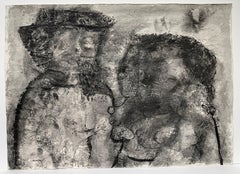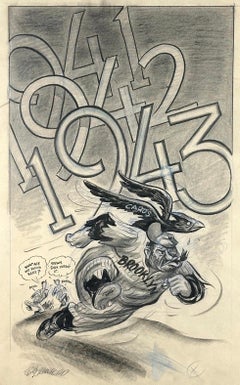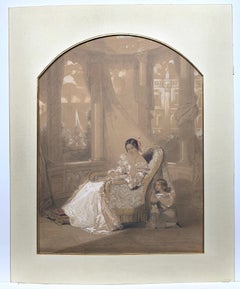Want more images or videos?
Request additional images or videos from the seller
1 of 11
Leo NowakGossipsca. 1940
ca. 1940
$800List Price
About the Item
About the Seller
4.9
Platinum Seller
Premium sellers with a 4.7+ rating and 24-hour response times
Established in 2007
1stDibs seller since 2015
440 sales on 1stDibs
Typical response time: 4 hours
Authenticity Guarantee
In the unlikely event there’s an issue with an item’s authenticity, contact us within 1 year for a full refund. DetailsMoney-Back Guarantee
If your item is not as described, is damaged in transit, or does not arrive, contact us within 7 days for a full refund. Details24-Hour Cancellation
You have a 24-hour grace period in which to reconsider your purchase, with no questions asked.Vetted Professional Sellers
Our world-class sellers must adhere to strict standards for service and quality, maintaining the integrity of our listings.Price-Match Guarantee
If you find that a seller listed the same item for a lower price elsewhere, we’ll match it.Trusted Global Delivery
Our best-in-class carrier network provides specialized shipping options worldwide, including custom delivery.You May Also Like
Portrait of Andy Warhol with Purple Hair in Pastel and Gouache on Paper
Located in Soquel, CA
Portrait of Andy Warhol with Purple Hair in Pastel and Gouache on Paper
Whimsical portrait by Ricardo de Silva (Brazilian, 20th Century). Andy Warhol is l...
Category
1980s Abstract Impressionist Figurative Paintings
Materials
Paper, Pastel, Gouache, Permanent Marker
$475
H 17.5 in W 14 in D 0.03 in
Polish Expressionist Profile Portrait Drawing TWO CHILDREN
By Josef Presser
Located in Surfside, FL
Genre: Other
Subject: Figures
Medium: Other, Gouache
Surface: Paper
Country: United States
sight size 17 X 13 inches
Emigrating to Boston in 1913 from Poland with his Russian-Jewis...
Category
Mid-20th Century Expressionist Figurative Paintings
Materials
Paper, Pastel, Gouache
1960s Gloria Dudfield Bay Area Figurative Orange, Yellow Gray Pastel and Paint
By Gloria Dudfield
Located in Arp, TX
Gloria Dudfield (1922-2015)
Untitled
c.1960s
Mixed media: gouache, pastel and encaustic on newsprint
11"x15.5" unframed
Unsigned
Gloria (Fischer) Dudfield
July 12, 1922 – May 27, 20...
Category
1960s Abstract Abstract Paintings
Materials
Paper, Pastel, Encaustic, Gouache
Mid Century Figurative Painting Purple, Orange, Gray, Yellow Pastel and Paint
By Gloria Dudfield
Located in Arp, TX
Gloria Dudfield (1922-2015)
Untitled
c.1960s
Mixed media: gouache, pastel and encaustic on newsprint
12"x19.5" paper cut unevenly, unframed
Unsigned
Gloria (Fischer) Dudfield
July 1...
Category
Mid-20th Century Abstract Mixed Media
Materials
Paper, Pastel, Encaustic, Gouache
Rare Modernist Hungarian Rabbi Pastel Drawing Gouache Painting Judaica Art Deco
By Hugó Scheiber
Located in Surfside, FL
Rabbi in the synagogue at prayer wearing tallit and tefillin.
Hugó Scheiber (born 29 September 1873 in Budapest – died there 7 March 1950) was a Hungarian modernist painter.
Hugo Scheiber was brought from Budapest to Vienna at the age of eight where his father worked as a sign painter for the Prater Theater. At fifteen, he returned with his family to Budapest and began working during the day to help support them and attending painting classes at the School of Design in the evening, where Henrik Papp was one of his teachers. He completed his studies in 1900. His work was at first in a post-Impressionistic style but from 1910 onward showed his increasing interest in German Expressionism and Futurism. This made it of little interest to the conservative Hungarian art establishment.
However, in 1915 he met the great Italian avant-gardist Filippo Tommaso Marinetti and the two painters became close friends. Marinetti invited him to join the Futurist Movement. The uniquely modernist style that he developed was, however, closer to German Expressionism than to Futurism and eventually drifted toward an international art deco manner similar to Erté's. In 1919, he and his friend Béla Kádar held an exhibition at the Hevesy Salon in Vienna. It was a great success and at last caused the Budapest Art Museum to acquire some of Scheiber's drawings. Encouraged, Scheiber came back to live in Vienna in 1920.
A turning point in Scheiber's career came a year later, when Herwarth Walden, founder of Germany's leading avant-garde periodical, Der Sturm, and of the Sturm Gallery in Berlin, became interested in Scheiber's work. Scheiber moved to Berlin in 1922, and his paintings soon appeared regularly in Walden's magazine and elsewhere. Exhibitions of his work followed in London, Rome, La Paz, and New York.
Scheiber's move to Germany coincided with a significant exodus of Hungarian artists to Berlin, including Laszlo Moholy-Nagy and Sandor Bortnyik. There had been a major split in ideology among the Hungarian avant-garde. The Constructivist and leader of the Hungarian avantgarde, Lajos Kassák (painted by Hugó Scheiber in 1930) believed that art should relate to all the needs of contemporary humankind. Thus he refused to compromise the purity of his style to reflect the demands of either the ruling class or socialists and communists. The other camp believed that an artist should be a figurehead for social and political change.
The fall out and factions that resulted from this politicisation resulted in most of the Hungarian avant gardists leaving Vienna for Berlin. Hungarian émigrés made up one of the largest minority groups in the German capital and the influx of their painters had a significant effect on Hungarian and international art. Another turning point of Scheiber's career came in 1926, with the New York exhibition of the Société Anonyme, organized by Katherine Dreier. Scheiber and other important avant garde artists from more than twenty-three countries were represented. In 1933, Scheiber was invited by Marinetti to participate in the great meeting of the Futurists held in Rome in late April 1933, Mostra Nazionale d’Arte Futurista where he was received with great enthusiasm. Gradually, the Hungarian artists began to return home, particularly with the rise of Nazism in Germany. Kádar went back from Berlin in about 1932 and Scheiber followed in 1934.
He was then at the peak of his powers and had a special flair in depicting café and cabaret life in vivid colors, sturdily abstracted forms and spontaneous brush strokes. Scheiber depicted cosmopolitan modern life using stylized shapes and expressive colors. His preferred subjects were cabaret and street scenes, jazz musicians, flappers, and a series of self-portraits (usually with a cigar). his principal media being gouache and oil. He was a member of the prestigious New Society of Artists (KUT—Képzőművészek Új Társasága)and seems to have weathered Hungary's post–World War II transition to state-communism without difficulty. He continued to be well regarded, eventually even receiving the posthumous honor of having one of his images used for a Russian Soviet postage stamp (see image above). Hugó Scheiber died in Budapest in 1950.
Paintings by Hugó Scheiber form part of permanent museum collections in Budapest (Hungarian National Museum), Pecs (Jannus Pannonius Museum), Vienna, New York, Bern and elsewhere. His work has also been shown in many important exhibitions, including:
"The Nell Walden Collection," Kunsthaus Zürich (1945)
"Collection of the Société Anonyme," Yale University Art Gallery, New Haven, Connecticut (1950)
"Hugó Scheiber: A Commemorative Exhibition," Hungarian National Museum, Budapest (1964)
"Ungarische Avantgarde," Galleria del Levante, Munich (1971)
"Paris-Berlin 1900-1930," Centre Georges Pompidou, Paris (1978)
"L’Art en Hongrie, 1905-1920," Musée d’Art et l’Industrie, Saint-Etienne (1980)
"Ungarische Avantgarde in der Weimarer Republik," Marburg (1986)
"Modernizmus," Eresz & Maklary Gallery, Budapest (2006)
"Hugó Scheiber & Béla Kádár," Galerie le Minotaure, Paris and Tel Aviv (2007)
Hugó Scheiber's paintings continue to be regularly sold at Sotheby's, Christie's, Gillen's Arts (London), Papillon Gallery (Los Angeles) and other auction houses.
He was included in the exhibition The Art Of Modern Hungary 1931 and other exhibitions along with Vilmos Novak Aba, Count Julius Batthyany, Pal Bor, Bela Buky, Denes Csanky, Istvan Csok, Bela Czobel, Peter Di Gabor, Bela Ivanyi Grunwald, Baron Ferenc Hatvany, Lipot Herman, Odon Marffy, C. Pal Molnar...
Category
Early 20th Century Modern Figurative Paintings
Materials
Paper, Charcoal, Pastel, Watercolor, Gouache
$5,500
H 15.75 in W 14.5 in
Turquoise Girl with Gold
By Charlie Mackesy
Located in Knowle Lane, Cranleigh
This mixed media painting on board by British artist Charlie Mackesy exemplifies his exceptional talent and distinctive style, showcasing his versatility across various mediums. Thro...
Category
2010s Contemporary Figurative Paintings
Materials
Charcoal, Mixed Media, Gouache, Pastel
$19,594 Sale Price
20% Off
H 25.6 in W 21.66 in D 1.19 in
Ladies in conversation
Located in Genève, GE
Work on paper
Golden wooden frame with glass pane
38.7 x 31 x 1.5 cm
Category
Mid-20th Century Modern Figurative Paintings
Materials
Crayon, Watercolor, Gouache
Still life , 65x50cm, paper/ pastel/ gouache
By Aleksandra Mato
Located in Yerevan, AM
Still life
Category
2010s Contemporary Figurative Paintings
Materials
Paper, Pastel, Gouache
$750 Sale Price
25% Off
H 25.6 in W 19.69 in
Soft Pastel Colour Harbour Scene with Boats and Church Tower France
By Fanch Lel
Located in Cirencester, Gloucestershire
Title: Soft Pastel Colour Harbour Scene with Boats and Church Tower France
by Fanch Lel (French b. 1930)
Size: 15 inches (height) x 9.75 inches (width)
Gouache painting on card, unfr...
Category
20th Century Impressionist Figurative Paintings
Materials
Gouache, Pastel
$461 Sale Price
30% Off
H 15 in W 9.75 in D 1 in
Framed Art Nouveau Period Painting A Greek Love Affair Theseus And Ariadne
By Antoine Calbet
Located in Sutton Poyntz, Dorset
Follower of Antoine Calbet.
French ( b.1860 - d.1944 ).
Theseus and Ariadne, Circa 1890 - 1910.
Mixed Media.
Watercolour, Gouache & Pastel
Image size 16.5 inches x 11.2 inches ( 42cm...
Category
Early 1900s Art Nouveau Figurative Paintings
Materials
Paper, Pastel, Watercolor, Gouache
$1,762
H 18.51 in W 13.39 in D 0.89 in
More From This Seller
View AllCoronel Retirado y Su Amante Esposa (Cuban Artist)
By Felipe Orlando
Located in Wilton Manors, FL
Felipe Orlando (Cuban-Mexican, 1911-2001). Coronel Retirado y su Amante Esposa, ca. 1970. Ink and gouache on paper with heavily built up layers of textured ground. Measures 13 1/4 x 18 3/8 inches. Signed lower left. Original label affixed on verso. Excellent condition. Unframed.
An anthropologist as well as a painter and engraver, Orlando, whose full name was Felipe Orlando Garcia Murciano, studied at the University of Havana and at the painting workshop of Jorge Arche and Víctor Manuel. He was a founding member of the Asociación de Pintores y Escultores de Cuba (APEC) and a professor at the Universidad de las Américas and the Universidad Nacional Autónoma de México, both in Mexico City. His style is influenced by the Afro-Cuban movement and pre-columbian art...
Category
1970s Abstract Abstract Paintings
Materials
Ink, Gouache
Same Old Story (Brooklyn Dodgers & St. Louis Cardinals Illustration)
Located in Wilton Manors, FL
Bill Crawford (1913-1982). Original illustration artwork depicting teams as they advance to the World Series. Depicted are representations of the St. Louis Cardinals and The Brooklyn...
Category
1940s Realist Figurative Paintings
Materials
Paper, Charcoal, Ink, Gouache, Pencil
Christmas Toys Greeting Card painting (Children's room decor)
Located in Wilton Manors, FL
Ferd Sondern (b.1923)
Christmas Toys, 1978.
Ink and watercolor on illustration board. Complete panel measures 10 x 18 inches.
Signed lower left. Credited on verso.
Printer nota...
Category
1970s Realist Animal Paintings
Materials
Ink, Watercolor, Illustration Board, Gouache
Mother and Child
Located in Wilton Manors, FL
Beautiful original painting by French artist, Alexandre de Valentini (1787-1887). Pencil and gouache on paper, 14 x 18.5 inches; 19 x 23.5 inches matted. Signed and dated with Paris...
Category
Mid-19th Century Academic Interior Paintings
Materials
Gouache, Pencil
$960 Sale Price
61% Off
Sailors at Cafe du Globe
By Charles Rocher
Located in Wilton Manors, FL
Charles Rocher (1890-1962. Sailors, ca. 1920s. Gouache on paper. Sheet measures 19 x 25 inches. Considerable damage and loss as depicted. Signed lower left.
Category
1920s Realist Figurative Paintings
Materials
Gouache
$560 Sale Price
20% Off
Life Magazine Satirical Society Cartoon Illustration
Located in Wilton Manors, FL
Barbara Shermund (1899-1978). Society Satirical Cartoon, ca. 1940s. Gouache on heavy illustration paper, image measures 17 x 14 inches; 23 x 20 inches in matting. Signed lower left. Very good condition but matting panel should be replaced. Unframed.
Provenance: Ethel Maud Mott Herman, artist (1883-1984), West Orange NJ.
For two decades, she drew almost 600 cartoons for The New Yorker with female characters that commented on life with wit, intelligence and irony.
In the mid-1920s, Harold Ross, the founder of a new magazine called The New Yorker, was looking for cartoonists who could create sardonic, highbrow illustrations accompanied by witty captions that would function as social critiques.
He found that talent in Barbara Shermund.
For about two decades, until the 1940s, Shermund helped Ross and his first art editor, Rea Irvin, realize their vision by contributing almost 600 cartoons and sassy captions with a fresh, feminist voice.
Her cartoons commented on life with wit, intelligence and irony, using female characters who critiqued the patriarchy and celebrated speakeasies, cafes, spunky women and leisure. They spoke directly to flapper women of the era who defied convention with a new sense of political, social and economic independence.
“Shermund’s women spoke their minds about sex, marriage and society; smoked cigarettes and drank; and poked fun at everything in an era when it was not common to see young women doing so,” Caitlin A. McGurk wrote in 2020 for the Art Students League.
In one Shermund cartoon, published in The New Yorker in 1928, two forlorn women sit and chat on couches. “Yeah,” one says, “I guess the best thing to do is to just get married and forget about love.”
“While for many, the idea of a New Yorker cartoon conjures a highbrow, dry non sequitur — often more alienating than familiar — Shermund’s cartoons are the antithesis,” wrote McGurk, who is an associate curator and assistant professor at Ohio State University’s Billy Ireland Cartoon Library & Museum. “They are about human nature, relationships, youth and age.” (McGurk is writing a book about Shermund.
And yet by the 1940s and ’50s, as America’s postwar focus shifted to domestic life, Shermund’s feminist voice and cool critique of society fell out of vogue. Her last cartoon appeared in The New Yorker in 1944, and much of her life and career after that remains unclear. No major newspaper wrote about her death in 1978 — The New York Times was on strike then, along with The Daily News and The New York Post — and her ashes sat in a New Jersey funeral...
Category
1940s Realist Figurative Paintings
Materials
Gouache


